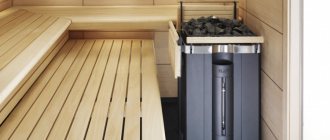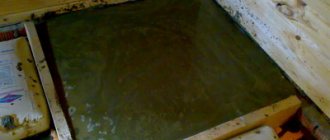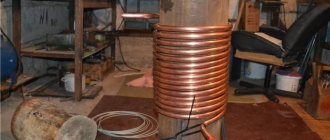What is a Russian bathhouse without a stove and steam? The whole essence of bath procedures comes down to obtaining healthy, scalding steam. The construction of a heater allows you to obtain the required amount of moist air and heat the steam room to high temperatures.
The hot stones of the heating device are able to accumulate and release heat into the environment, and the water falling on them turns into healing steam.
Wood-burning sauna stove: what to choose based on?
There are several criteria that instantly eliminate many ovens.
Power
Firstly, you need to correctly calculate the power of the stove, do not take one that is smaller or right next to each other, because working at the limit usually greatly shortens the life of the device - the iron burns out faster.
You should not take a stove with a large power reserve, because when using a small percentage of the rated power, the efficiency is usually greatly reduced.
IMPORTANT! We recommend choosing a stove a couple of kilowatts more powerful than what is needed according to calculations.
The calculation is relatively simple: the main figure is the volume of your steam room, and then numbers with increasing factors are added to it.
This happens if the door to the steam room is made entirely of glass (add one and a half cubes to the volume), if there are surfaces without thermal insulation - tiles, glass, etc. (we measure their area, multiply by 1.2 and add to the volume), and also if the bathhouse is a log house without any thermal insulation at all (we immediately multiply the volume by 2).
You should also consider whether the stove will heat adjacent rooms or whether another heat source will be located there.
In winter and summer, the heating time for the steam room will be different. And since stove manufacturers usually indicate the minimum and maximum volumes for which the stove is designed, in winter you should focus on the first number.
Preferred sauna type
If the owner is a fan of the Finnish sauna, then his choice is practically unlimited: all models of metal stoves are suitable for him. He doesn't need a brick oven at all. And an electric stove can be a good alternative to a wood-burning heater - provided that you don’t mind burning electricity.
It’s more difficult for fans of the Russian bathhouse. The best option for them is still a brick stove, but a compromise can be reached if you line a high-quality metal stove, for example, made of cast iron, with brick.
Stoves with mesh heaters, open heaters, or with a body that is not lined with brick or stone are not suitable for a Russian bath.
As mentioned above, a closed heater is required in the stove for a Russian bath.
An electric stove is suitable for a Russian bath only if it is a “thermos”, that is, a closed electric heater. Or if the electric heater has a steam generator and the range of temperatures achieved varies widely. (Because you can't do high temperature and high humidity at the same time).
What remains are those who like to steam, who like to alternate modes to suit their mood. In this case, the stove must again have a closed heater, but it can be combined with an open one. Electric furnaces with different modes are also suitable.
Durability
By the way, this is not such an unimportant factor. Many people would like, if they invest in a stove, to have it last for a long time.
Brick and cast iron stoves will be durable (with proper operation). In the latter case, as already mentioned, it is necessary to clarify not only the thickness, but also the grade of cast iron.
Steel stoves made of stainless steel with a high (17%) chromium content will be durable and expensive. Buyers who prefer inexpensive solutions also have the opportunity to make the best choice.
ON A NOTE! The service life is shortened not only by working at the limit, but also by installing a gas burner in a wood-burning stove - the temperature of the flame increases twice, if not more, and the metal is not designed for this. It is especially bad if the gas flame touches the walls and upper ceiling of the stove.
Varieties and recommendations for selection
The material of the stove primarily depends on the volume of the bath. Let's consider several options:
- A spacious building with several rooms requires a brick stove that can give off heat for a long time.
- In a modest-sized steam room with a volume of 30 to 35 m3, you can install a stove with a cast iron body.
- For a sauna with the most compact dimensions, a steel stove is also suitable.
The material from which the walls of the bathhouse are made is also important. A frame made of birch or linden is called light, and one made of oak is called heavy. These terms should not be taken literally: the word “heavy” in this case does not mean weight, but the presence of tannins in the wood
People with poor health, as well as women and children, are not recommended to take a steam bath in such baths.
These terms should not be taken literally: the word “heavy” in this case does not mean weight, but the presence of tannins in the wood. People with poor health, as well as women and children, are not recommended to take a steam bath in such baths.
Table: power and weight of stones for linden, birch and oak baths
| Bath type (ceiling height from 2.2 to 2.4 m) | Power (kW/m3) | Weight of stones (kg/m3) |
| Linden | 0,5 | 2,7 |
| Birch | 0,7 | from 3.6 to 4 |
| Oak | 1,2 | 6 |
According to the method of heating the stone backfill, sauna stoves are divided into two types.
Flow-through stoves
In such stoves, the heater is not separated from the firebox by an impenetrable barrier, so the flue gases leak through it before entering the chimney.
Thanks to this solution, the stones warm up extremely quickly, but you also have to put up with some disadvantages:
- The design of the furnace becomes more complicated.
- The stones have to be cleaned of soot at some intervals.
- Adding water (pouring water or kvass on the stones) is possible only after the fuel has completely burned out.
- You can only use fuel that produces a small amount of soot (pellets, aspen, etc.).
With a blind heater
In this option, the stones are fenced off from the firebox and flue with a stove. In terms of advantages and disadvantages, the situation is reversed: the heater takes a long time to heat up, but does not require cleaning and can be used to produce steam at any time.
Stove option with a solid heater
In order for the stones in a blind heater to heat up sufficiently, two conditions must be met:
- the stove must be metal (the thermal conductivity of the brick partition will not be enough);
- have a power of no more than 25 kW (the bathhouse should consist of one room with a volume of up to 45 cubic meters).
As the power of the stove increases, its dimensions increase, and the contact area of the heater with the partition, in accordance with the square-cube law, does not “keep up” with its volume.
It should also be taken into account that the ceiling height in a steam room with a solid heater should not exceed 2.2 m, otherwise instead of light steam you may get heavy steam.
Of all the listed options, only a steel stove is available for self-production at the amateur level. A brick one can also be built at home, but due to the difficult operating conditions, only an experienced stove maker can do this. Cast iron sauna stoves are manufactured only in factory conditions.
Water container
Immediately before building the stove, it is important to determine the volume of the tank in which the water will be heated. The volume of the tank will depend on the intensity of visiting the steam room
So, the calculation is made based on one liter of hot water per person. It is best to use an open container. Although there will be evaporation, there are a number of positive aspects:
- Convenient when filling the container.
- The ability to carry out maintenance or repair of the internal part if necessary, for example, remove scale, clean and dry.
- In winter, completely remove water, protecting the tank from freezing the water in it.
What is the difference between a Dutch woman and a Swedish woman, I confuse them
The Dutch oven was created specifically as a heating stove, but now they are making a hob in it. This device is much simpler than a Russian stove: a combustion chamber with a labyrinth of smoke ducts on top. The smoke travels along this winding path for a long time, and thanks to this the heat does not escape. In our country, Dutch was traditionally decorated with tiles - this option is considered a classic.
The Swedish stove is an improved version of the Dutch stove with a vertical system of smoke circulation channels. Swedish scientists optimized it in the mid-18th century by expanding the lower part and adding an oven to the side.
The Swedish oven is the result of careful calculations. With its quite compact size, it warms up quickly, allowing you to cook food, heat the house, etc. The efficiency of the Swedish stove is slightly inferior to that of the Russian stove, but this design requires precise calculations. They drown the Swede twice a day.
Technology for constructing a sauna heater with your own hands
So, how to make a sauna heater out of brick yourself to get multifunctional heating equipment?
The first stage of construction is choosing a suitable location for the furnace. The installed stove must effectively heat all the main rooms of the bathhouse - the steam room, washing compartment and dressing room. This will allow you to install a single chimney, equipped with triple channels for smoke removal.
It is also necessary to decide on the type and volume of the hot water tank. The technical characteristics of the device will depend on the intensity of use of the steam room, taking into account the rate of water consumption per person, which ranges from 7 to 10 liters.
For a brick heater, it is better to choose an open water tank, which has some advantages:
- ease of control over the water level;
- availability of repairs and maintenance of the hull;
- the ability to remove water in winter to prevent it from freezing.
Construction of a furnace foundation
The next stage of work is the arrangement of the base for the furnace equipment. A brick heater for a bathhouse with your own hands requires preliminary preparation of the foundation.
The work is performed in the following order:
- Dig a pit to a depth below the soil freezing level (average value - 80 cm). The dimensions of the pit must exceed the dimensions of the furnace by 15 cm around the entire perimeter.
- The bottom is equipped with a waterproofing cushion. The first layer, up to 15 cm high, is covered with sand, compacted and moistened with water. The second layer of broken bricks or stones is also compacted. The gaps between the individual elements are filled with sand and moistened. The thickness of the second layer is 25 cm. After complete shrinkage of the sand, the third layer of crushed stone of the middle fraction is backfilled and compacted.
- Install wooden formwork, the internal dimensions of which correspond to the dimensions of the base. The upper part of the formwork is mounted level. Reinforcing bars are installed in its cavity to create a strong frame. The distance between the reinforced frame and the outer walls of the formwork is 5 cm.
- The concrete mixture is poured, tamped with a wooden beam and leveled to the building level. The mixture is poured to the top level of the formwork to obtain an even screed. In this case, the formwork is located on the same level with the rough base of the bathhouse.
- The wooden frame is dismantled after the concrete base has completely dried. Next, the concrete is treated with a double layer of liquid tar, and the space between the foundation and the walls of the pit is filled with a sand-gravel mixture. The finished area is covered with polyethylene and left for a week until completely dry.
To fill the foundation, you can use several types of mortars: cement, lime and cement-lime.
Selection of materials for stove masonry
For masonry of the heater, high-quality heat-resistant bricks without defects or damage are used. All products must be the same shape, with smooth edges. It’s easy to check the quality of the material: if the brick crumbles into large pieces when dropped, then it is suitable for construction work.
The optimal size of one product is 12.5 × 25 × 6.5 cm. For working chambers in which the heating temperature reaches 300 degrees, it is recommended to use fireclay bricks. It is resistant to overheating, deformation and cracking.
No less important is the choice of masonry mortar based on heat-resistant white clay. You can make masonry mortar yourself or purchase it ready-made.
For hot areas of the furnace, a solution with a low cement content (up to 9%) or a ready-made composition for fireclay bricks is used, which, when exposed to high temperatures, turns into a monolithic base.
For cold areas, such a solution is not used, since insufficient surface heating and high humidity in the room can lead to cracking and damage to the masonry.
For external brickwork, you can use a solution based on clay and quartz quarry sand.
You can verify the quality of clay for masonry mortar as follows: soak 250 g of clay in cold water for 24 hours. Afterwards, the material is rolled into a ball and left to air dry (a prerequisite is shade and no direct sunlight). After a couple of days, the workpiece is dropped from a height of 180 cm onto a stone base. If at the same time it crumbles into large pieces, then the material can be used in work.
Types of fireboxes
Stoves are distinguished by how the firebox is folded. The method of using the device and the quality of the steam depend on this.
In black
Vintage version of the equipment. There is no chimney. Our ancestors built stoves this way.
The design is classified as having a high fire hazard.
Most stove makers have abandoned this method of laying the firebox.
In gray
In the gray version of the device, the stove is equipped with a chimney. But it is built in such a way that part of the combustion waste (soot, soot) settles inside the brick walls of the chimney. Therefore, there is always a risk of a fire inside the stove and the flame spreading to the room.
In white
There is a full-fledged chimney through which all the smoke goes outside without entering the room.
In such ovens, the stones are covered with a dense metal lid or door (optional). They are opened only after all the wood has burned out.
There are products where stones are separated from flue gases by a hob. The stove operates continuously (heating is performed to take a bath) or periodically (thorough one-time heating before taking a bath).
It is recommended to use hardwood firewood for heating sauna heaters. They do not emit a tarry burn after burning. A wood stove is easier to regulate and maintain its temperature at the same level.
We recommend that you read:
- How to clean a chimney
- How to install a stove in a bathhouse
Pros and cons of brick sauna stoves
In favor of a brick oven, it is worth highlighting the following:
- Environmentally friendly raw materials, which is safe for health.
- Long service life. It can last up to 100 years or more.
- Wear resistance and strength of the material.
- The ability to retain and release heat for a long time. The water in the tank, heated in the evening, will be warm until the morning.
- The steam produced is of good quality.
- Combustion products do not pass through the inner heater.
- The stove is capable of heating large rooms.
- Brick is a fireproof material.
Among the disadvantages, users note that:
- It will not be possible to build a structure quickly and without experience. Here you need to correctly draw up a drawing, carry out calculations, and understand the principles of brickwork.
- The oven is heavy. Therefore, a reliable foundation must be poured under it.
- The design takes a long time to heat up compared to its metal counterpart.
- Prolonged heating entails increased consumption of wood fuel.
- High cost of work (if ordered from a stove maker). Large amounts of money spent on purchasing materials.
Despite so many shortcomings, the advantages of the design are much more significant, which is why the demand for the construction of a brick oven with a water tank is only growing.
Advantages and disadvantages of a brick kiln
No matter how profitable and easy to use metal stoves are, owners with worldly experience prefer proven brick structures. A brick sauna stove has the following advantages:
- Heat capacity
. The stove is capable of retaining heat for 6-8 hours and heating several rooms (depending on location).
- Energy independence
. A wood-burning stove is an ideal option if there is no gas supply and there are power outages.
- Operating savings
. There is no need to install a gas pipe or run wiring and then pay bills. Firewood will cost much less (especially if you prepare it yourself).
- Comfort
. Such stoves produce rich, but not scalding (light) steam and soft heat. The atmosphere of the steam room does not make breathing difficult and is ideal for those who like to steam frequently and tastefully.
Compact brick structureSource tproekt.com
- Environmental friendliness
. Both the brick from which the stove is made and the firewood are environmentally friendly materials that are safe for health.
- Design
. There are real masterpieces of stove art with stunning architecture and design.
- Fire safety
. Provided with design features that fully comply with SP 7.13130-2013.
Brick kilns are inferior to other designs due to disadvantages:
- Difficulties in execution
. The masonry process has nuances, and it is not easy to find a competent stove maker.
- Size
. A large stove eats up precious steam room space.
- Price
. The pleasure of making bricks is not cheap: you need to build a foundation, purchase high-quality bricks and pay for the services of a craftsman.
- Time
. The stove heats up, and the steam room takes a long time to heat up.
- Care
. Systematic cleaning of the ash pan and periodic cleaning of the chimney are required.
A brick oven emits soft heat, making it as comfortable as possible for a person. Source tutknow.ru
Tips for those who are taking up baking for the first time
Make a detailed drawing of the heater indicating all dimensions
Moreover, it is important to do this regardless of what you plan to make the stove from - metal or brick. A concrete or rubble concrete monolith foundation must be installed under a brick oven. A brick foundation using a lime or cement mixture is allowed only if the surrounding soils are dry. The foundation must protrude beyond the contour of the stove itself by at least 5 cm on each side. When the top of the foundation is level with the floor line, level it with a cement mixture, and then lay a layer of waterproofing, such as roofing felt, in two layers. Lay out the heater not in segments, but in rows, observing the order and dressing of the seams
Moreover, the thickness of the seams should not exceed 3 mm. It is not allowed to tie bricks of different types in adjacent rows. The grates are installed at a height of 1 brick. A wood firebox can have different sizes, but the optimal dimensions of its opening are considered to be the following: 25 cm in height, 35 cm in width and from 40 to 60 cm in length. The pipe in a sauna heater is usually made of a top-mounted type. Be sure to leave a gap of about 10 cm between the brick pipe and any wooden roofing elements. And where a metal or asbestos-cement pipe passes through the roof, cover the adjacent elements with felt soaked in clay mortar. The wooden floor is protected with asbestos cardboard and roofing steel sheets.
Also be sure to watch the video and photo materials on our website. This will help you get an idea of the masonry process and some of the nuances.
Basic rules for installing a stove for a Russian bath
In order for a Russian sauna stove with a closed heater to serve faithfully for many years and bring pleasure to those who like to take a steam bath, you need to know the rules of its construction and strictly follow them.
Experts recommend listening to the following advice:
- The firebox door and the heater door in a sauna stove with a closed heater “looked” in different directions.
- Installing a metal stove for a Russian bath with a closed heater requires the construction of a concrete foundation that can prevent the possibility of a fire if sparks hit the floor. The recommended base height is 300 mm or more, after which two rows of fireclay are laid, held together with clay mortar.
- The basis of such a stove with a closed heater for a bath is prepared in advance. At the point where the pipe exits the furnace masonry, a thickening of 150 mm is made.
- If there are wooden elements too close to the hot surface of the stove, they should be covered with a thermal insulation base.
- The place where the pipe exits the furnace into the roof through the ceiling hole is finished with a plaster solution, and then treated with lime mortar.
- Brickwork is constructed on the roof for the pipe exit, the height of which should not be less than 500mm. This will prevent the roof from catching fire and the entire structure from catching fire.
Foundation requirements
They prefer to build a bathhouse with a closed heater from wood, and therefore it is necessary to take the fire safety requirements for this category of objects seriously. All walls and ceilings must be covered with non-combustible materials. Installation of the stove indoors is done at a distance of at least 250 - 300 mm from the walls. To get maximum heat transfer, it is worth placing a sauna stove with a closed heater in the center of the room.
The characteristics and area of the foundation depend on the material used to make the stove for a Russian bath with a closed heater, as well as its dimensions. The area of the base is calculated in advance.
Then you need to start doing the following:
- dig a hole 500 mm - 600 mm deep;
- cover the bottom with a layer of wet sand;
- the second layer is broken brick or crushed stone (layer thickness is about 100 mm);
- build formwork from boards;
- install reinforced mesh;
- pour concrete mortar into the formwork (concrete must be purchased of proper quality. Otherwise, the foundation will crumble over time);
- Allow the solution to completely harden (a couple of days);
- remove the formwork;
- Cover the top layer of the foundation with roofing felt to enhance waterproofing.
Useful information: The height of the foundation above the floor level must be at least 100 - 150 mm.
Recommended heater dimensions
The size of a stove for a Russian bath with a closed heater is influenced by the methods of insulating a Russian bath, the quality of the material used, the immediate dimensions of the steam room, the stones used for heating, their size and quantity. It is believed that with a steam room volume of 15 sq.m. It is enough to install a stove with a closed heater to generate steam and establish the proper temperature conditions with dimensions of 300mm x 400mm x 300mm. These sizes are recommended, but not required, so they can be slightly adjusted up or down.
Before you start making a metal stove, you need to decide on the individual volume of the heater, based on the dimensions of the proposed design. It is advisable to make a preliminary drawing of the finished furnace before starting work. It is necessary to keep in mind that the firebox is 40 - 50% larger in volume than the heater.
The location of the heater inside the stove is of no small importance. Practice shows that the best option is in the upper part of the rear wall
There is always a significant temperature, which promotes deep heating of the stones.
A stove with a closed heater for a bath requires regular maintenance. She needs to determine a place for a free approach, supplying water, and laying stones. The location of the hatch should make it possible to reach the most distant point with your hand without making excessive efforts. The water supply must be safe to avoid body burns.
Tubes are placed inside the heater, which come into contact with all the stones. A funnel is made at the water supply point. As soon as the pipes are separated, stone lining occurs. Water flows through the tubes, hits the hot stones, turning into steam.
Preparatory work
Selecting a water tank
One of the main components of a heating device is a tank or container for water. The volume of the tank should be selected before all construction work begins.
It depends on the number of people and the visit to the bathhouse: the more people who want to take a steam bath, the larger the volume of the tank needs to be used. One liter of water is usually consumed per person.
It is best to use an open tank as a tank. It will be more convenient to fill such a container with water. During operation, scale may appear on the tank. It is easier to eliminate it if the container is open.
If you do not use the sauna in winter, it is better to remove all liquid from the container. This way you prevent the water from freezing and damaging or deforming the tank itself.
Foundation of the future furnace
One of the most important components of any furnace is its foundation. A brick stove with a closed heater for a Russian bath made by yourself must be on a high-quality foundation.
The foundation depth should be below the soil freezing level by an average of half a meter. The area of the foundation should be larger than the furnace by a few centimeters around the perimeter.
Stages of building a foundation:
you need to dig a hole to install the formwork. Cover the bottom with sand (about 15 cm) and fill it with water to compact it. Small stones are placed on the surface, after which they are compacted. The formwork is made from boards. The internal size of the formwork must be identical to the size of the foundation
The structure is covered with film and left for about seven days.
What brick should I use?
How to choose quality brick? Before purchasing a whole batch of bricks, check its quality. To do this, purchase several bricks and break them. If you have a few large pieces left over, this is a great material.
If it crumbles into small parts, it is a bad material. It is not the size of the brick itself that is important, but the identical parameters of each individual rectangle.
There is another type of brick that is used only in the fuel zone of the furnace. It is called fireclay. This material is resistant to heat. Fireclay has a larger size compared to others. But it can be easily filed and made to the desired size.
Preparation of the solution
- for external masonry
- for the firebox and chimney.
The first one is easy enough
It should be small and uniform. And it is best to choose clay that has overwintered in open areas. It should also be ground through a sieve, after wetting it with water.
The proportions of the components may vary. It depends on how high quality clay is used. But usually this ratio is 1 to 2 (1 part clay and 2 sand), water should be approximately 1/4 of the amount of clay.
To strengthen the fireclay brick (for laying the firebox), use a solution of heat-resistant clay (it is white). When exposed to high temperatures, it compresses tightly and forms reliable protection against heat. All solutions must be mixed gradually until the consistency of liquid sour cream.
Types
Sauna stoves can be divided into different groups depending on different criteria. The main ones are the material and fuel used.
By material
Depending on the material from which the stove is made, there are two types of equipment:
- Brick. Classic stoves for Russian baths. They look attractive and retain heat for a long time. Since the bricks are heavy, a separate foundation must be built under the furnace.
- Metal. Modern designs that take up a small amount of space are suitable for heating residential premises and heating bath buildings. They heat up quickly, but cool down quickly after the fuel burns out.
A separate type of furnace equipment is combined models. The combustion chamber is assembled from metal, the metal surfaces are lined with brick or natural stone.
By fuel type
For a bath, you can choose a wood-burning stove or an electric heater. Design Features
- Wood-burning heater. Solid fuel is used for kindling. Thanks to the burning of wood, a special atmosphere is created inside the bathhouse, which allows you to better relax and unwind. Firewood must be prepared in advance by choosing a suitable storage location. The stove with a chimney must be regularly cleaned of ash and soot, and the combustion process must be monitored.
- Electric heater. Powered by electricity. They are less demanding to maintain and heat up evenly. There is no need to create a separate place to store fuel. You can precisely control the temperature.
The choice of stove depends on financial capabilities and personal wishes.
The need to shield the walls
In addition to the fact that a closed heater is required, it is also important to shield the flow of hard radiation coming from the metal walls. A number of manufacturers create double metal casings around the unit body that reduce convection.
For the same purpose, cladding with natural minerals can be used. Similar stoves are offered by many manufacturing companies, but since natural finishes are very expensive, the products cannot be called cheap.
Another way to reduce heat transfer from the walls of the product is to line the inside of the firebox with refractory (ША-8 or ША-5) bricks. To do this, it needs to have a significant volume. It is highly not recommended to use cement mortar, as it will crumble. There is a way to use fireclay “dry”.
To lay bricks without mortar, they must be trimmed to form a lock for the connection. They can be placed on a spoon or upright, depending on how it is more convenient to place them in the firebox
It is important not to use the stone container, otherwise you will have to wait a long time for steam.
Making the foundation for the heater
To prevent the stove from sagging, tilting and cracking, you should know a few subtleties when building a foundation:
- the foundation of the bathhouse building and the foundation of the heater should not be connected to each other. The distance between these foundations must be at least 50 cm. For insulation, this empty space should be covered with sand;
- The foundation of the stove floor must be deep enough. At a minimum, the depth should be at least 70 cm;
- the foundation should be larger than the size of the heater, approximately half a brick in each direction.
The construction of the foundation begins, naturally, with digging a pit. After the pit is dug, a layer of bricks without mortar is laid in it. Just. And they compact well. The next rows of the foundation are laid as usual, on the mortar. With dressing. A cement screed and waterproofing are made on top of the foundation.
Fire safety measures
- Maintain a distance from the firebox to the stove surface of at least 50 cm.
- When installing the pipe, a gap of 10 cm is provided to the wooden components of the roof.
- If the structure is located near a wall, a distance of 10-15 cm must be maintained.
- The pipe above the roof surface should rise 50 cm or more. Otherwise, due to insufficient draft, the stove will smoke and burn poorly.
- A steel sheet is laid on the wooden floor in the bathhouse on the side of the fire door so that falling coal does not set the entire structure on fire.
Features of designs with an internal heater
Metal stoves with a closed heater consist of a fuel chamber, where wood is burned, and a compartment for stones located on top.
Air enters the fuel chamber through the grate; a retractable ash pan is located below. A chimney is installed above the heater to remove smoke and some of the hot air.
A special door-latch near the compartment with stones allows you to regulate the air temperature in the room and the amount of steam. The stoves are also equipped with a tank for heating water, which is located on the side.
A brick stove with a closed heater is similar in design to a metal appliance, but is usually more massive. For long-term heat transfer, brick devices are equipped with additional chimney channels. The heat from such a stove is retained for two days. The dimensions of the brick fixtures allow you to conveniently position the compartment with stones and the tank for heating water.
Steam gun
The operation of a closed heater depends on how isolated it is from the walls of the unit and the state of the air in the steam room. The better these indicators are, the hotter the stones will be able to heat up. However, in this case there is a problem with how to supply water to the stones.
In order to obtain steam inside the heater, a system of tubes with holes is installed. A glass or funnel is attached to the outside and water is poured in. It flows down the tube down the unit. Such a device is called a heat gun. It got its name because the escaping steam makes loud sounds, reminiscent of a gunshot.
What does it represent?
This version of the stove is used if you need to operate the bathhouse all day and for several people. This type of design quickly heats up the steam room. It has good heat capacity, dry air, heat close to 90 degrees, pleasant appearance from the outside, neat proportions. It is better to build a bathhouse of this type in small rooms up to 25 square meters. m, since huge spaces are difficult to heat to the required temperature. The size of the stove is often 77 by 77 cm to heat a space of 3 by 3 meters. The approximate quantity of bricks required for this size of oven is 290 pieces. The design includes a metal boiler for water and an open niche for stones with a volume of up to 120 kg.
What is needed for the construction?
To lay a stove of this kind, a minimum amount of skills and materials is required. The only thing that is required is conscientiousness in work, basic knowledge about laying a stove, some bricks, and various types of accessories for the stove. The pebbles are placed on a grate above the fuel chamber, but the sequence must be observed: some of the largest samples should be at the bottom, and smaller ones at the top. If you overdo it a little and attach a galvanized lid, you can cover the stones with it after heating to a certain temperature. This will help keep the heater longer in hot weather.
Can a fireplace be installed in any room of the house or are there restrictions?
There are a lot of restrictions. It is not allowed on the second floor (usually the ceilings are not designed to support the weight of even a small fireplace), in a regularly shaped room with an area of at least 20 square meters with three-meter ceilings, so that the volume of air is sufficient for normal combustion. But a fireplace that is too small will not be able to heat a large room. For masonry fireplaces there is a rule:
area of the combustion window = 1/50 of the area of the room.
The firebox window should “look” into the middle of the room.
Rules for successful masonry
The efficient operation of the furnace largely depends on how well the masonry technology was followed. This is influenced by the quality of the bricks, the method of doing the work, the binding solution and the degree of moisture of the material. The result of proper masonry will be a solid structure. An unsatisfactory result is considered to be a structure made without bandaging the joints, separated by vertical lines of seams.
During the work, one important requirement must be met: it is necessary to prevent the gases formed during combustion from escaping to the outside. In addition, the entry of air into the furnace structure is also not welcome. Careful selection and adjustment of the material will help make the masonry beautiful and durable
It is important that the bricks are split and hewn. Before you start working, you need to soak the cobblestones in water, lowering them into a container for 10 seconds, then lay them in a row on a layer of clay
Careful selection and adjustment of the material will help make the masonry beautiful and durable.
It is important that the bricks are split and hewn. Before you start working, you need to soak the cobblestones in water, lowering them into a container for 10 seconds, then lay them in a row on a layer of clay
Craftsmen advise applying the mortar by hand, and using a trowel only when doing external masonry.
The brick laying process is as follows:
- take the block in one hand, grab the clay with the other and apply a thin layer to the brick;
- level the surface;
- place the product in a specific place;
- while pressing on the cobblestone, perform forward and backward movements;
- remove excess mortar on both sides of the masonry with your hands;
- with the next brick, repeat the above steps, in this case it is necessary to apply the solution also to the end of the block, with which it will be pressed against the first one.
There is another way to lay bricks:
- apply the solution to the masonry site, level it by hand;
- take the prepared cobblestone and lubricate the end with the composition;
- place the product in its place in the row, press it against adjacent elements, while performing sliding movements with your hand.
Do not forget to soak the brick, otherwise it will begin to take moisture from the working solution. This is fraught with dehydration and thickening of the composition, which interferes with the removal of its excess and leads to the formation of unsightly thick seams.
Vertical or horizontal format?
One of the key issues that you will have to decide if you intend to make a sauna stove from a pipe. Of course, it directly depends on the size of the steam room.
Vertical - ideal for small spaces. The grate bars and the direct firebox are placed in steps, one above the other, which ultimately allows you to save useful space around. The use of this format has recently become noticeably more frequent, especially among professionals. It is better to avoid disputes about which stove is best suited for a bath: make a decision based on your specific situation.
Horizontal is a solution that fits well into the format of spacious bath rooms. At the same time, this is the classic version that is used almost everywhere. Characterized by a slightly enlarged firebox compartment. Often, for practicality, part of it goes into the dressing room, which allows you to speed up the sometimes rather tedious process of kindling.
Agree that it is much more convenient to regulate the temperature from it without wasting time moving from one room to another. In addition, during such “raids” the air actively circulates throughout the bathhouse and prevents its full heating.











